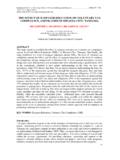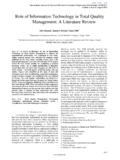Transcription of Comparison of Avpu with Glasgow Coma Scale for …
1 IOSR Journal of Dental and Medical Sciences (IOSR-JDMS) e-ISSN: 2279-0853, p-ISSN: 14, Issue 12 Ver. V (Dec. 2015), PP 22-29 DOI: 22 | Page Comparison of Avpu with Glasgow Coma Scale for assessing Level of Consciousness in Infants and Children Subba Rao1, Srinivas2, 1. Associate Professor of Pediatrics, Niloufer Hospital, Hyderabad, India 2. Assistant Professor of Pediatrics, Niloufer Hospital, Hyderabad, India 3. Post Graduate in Pediatrics, Niloufer Hospital, Hyderabad, India Corresponding Author: Rao, Associate Professor of Paediatrics, Niloufer Hospital, Red Hills, Hyderabad, Abstract: Background: Coma is a common problem in pediatric patients with high morbidity and mortality. Early recognition is important and several coma scales like GCS have been developed for recording level of consciousness.
2 The AVPU Scale is simpler, easy to use and easy to remember. We conducted this study to know how the AVPU Scale corresponds with GCS in children. Aims And Objectives: To compare AVPU Scale with GCS for assessing level of consciousness in infants and children admitted in emergency department with both infectious and noninfectious etiology. Study Design: Observational study. Setting: Emergency department of pediatrics, Niloufer hospital, Hyderabad. Materials And Methods: Patients aged between 2months to 12years admitted in emergency department requiring assessment of level of consciousness were included. Each patient s level of consciousness is then assessed by using AVPU and GCS Scale and compared. Attained data is analyzed statistically. The mean GCS score for each AVPU component was determined and a one way analysis of variance technique was employed.
3 Results: 85 patients were included in the study to meet the required sample size with a minimum of 20 patients in each category of AVPU Scale . One way analysis of variance indicated that all components of AVPU had significantly different average scores p< is a good correlation with a constant relationship between the two scores in pediatric patients with causes of impaired consciousness. Conclusion: AVPU response Scale is comparable to GCS in assessing level of consciousness in infants and children and in both infectious and noninfectious etiology. P&U of AVPU indicates necessity for intubation. Keywords: AVPU, Coma, GCS, Level of consciousness. I. Introduction Traumatic and non-traumatic coma is a common problem in Paediatric practice with a potential for catastrophic high mortality and morbidity.
4 Disturbances leading to altered level of consciousness may result from varying causes which can be broadly divided into traumatic and non-traumatic causes. Traumatic causes of altered level of consciousness in children include accidents, non-accidental injuries and birth injuries. Non traumatic causes are more varied and include infections of central nervous system, hypoxic ischemic encephalopathy, metabolic disorders, cerebrovascular disorders, endocrine abnormalities, exogenous poisons and structural and degenerative central nervous system Early recognition of coma is essential and several coma scales have been developed for recording depth of consciousness that are widely used in clinical practice in adults and children. The scales should be reliable, with little variation between observers and in test retest by one observer, since this promotes confidence in the assessments at different time points and by different examiners.
5 This is particularly important when the patient is being assessed by personnel dealing with adults as well as children, discussed on the telephone, handed over at shift change, or transferred or hospital between units. Studies are conflicting on the best quick assessment tool for neurologic status. Scales can be used to initially evaluate a patient for critical conditions such as impending airway compromise or brain herniation in a medically ill or trauma patient. Furthermore, these scales provide a baseline that is used for serial examinations and for communication with The Glasgow Coma Scale (GCS) is a 13-point Scale described in 1974 by Teasdale & Jennet. The GCS evaluates consciousness by scoring a response in three areas: eye opening, motor response and verbal performance and was designed for assessment of consciousness in head injury patients and has become ubiquitous since, now being put to many uses for which it was not originally have been concerns expressed regarding complexity, spurious precision, lack of agreement between individuals and groups of clinicians, and therefore validity of the Scale .
6 Although the GCS has not been validated as a prognostic scoring Comparison of Avpu with Glasgow Coma Scale for assessing Level of Consciousness in DOI: 23 | Page system for infants and young children as it has been in adults, modified GCS is commonly used in the assessment of pediatric patients with an altered level of consciousness. Patients with a GCS score 8 require aggressive management, including stabilization of the airway and breathing with endotracheal intubation and mechanical ventilation. Assessment of the GCS in children adds another layer of complexity3, as there is a need to relate normal responses to minimum normal developmental A child under 6 months of age for instance may still demonstrate primitive reflex responses and simply withdraws or flexes after any form of painful It has also been shown that the 6-poin motor Scale is inappropriate for use below the age of 6 main difference between paediatric and adult GCS has been in verbal scoring.
7 The Advanced Paediatric Life Support course uses a detailed verbal subscore utilising descriptive terms which can be applied across spectrum of age, with a score of 5 for Alert also being described as babbles, coos words to usual ability , and a score of 4 described as Less than usual words; spontaneous irritable cry .6 However a salient and important point is that paediatric GCS scoring may be particularly challenging, and often requires consistent practice to become familiar with its A number of criticisms have been leveled against the GCS since its inception, one being its complexity, leading to a lack of agreement among clinicians attempting to quantitate consciousness for the purposes of diagnosis, intervention or prognosis, and another being the lack of contribution of the eye opening and verbal scales to the overall discrimination of the Scale .
8 The AVPU scoring system is used to determine both a child s level of consciousness and cerebral cortex function. Unlike the GCS the AVPU Scale is not developmentally dependent a child does not have to understand spoken language or follow commands, merely respond to a stimulus. The child is scored according to the amount of stimulus required to get a response, from alert to unresponsive. A very simple (AVPU) has been recommended for immediate emergency assessment of level of consciousness, by nursing, medical, or paramedical staff at the scene of an accident or collapse or in the resuscitation room. It has been said that to be accurately and consistently applied, a clinical Scale must be easy to use and The GCS was compared to the AVPU score with adult studies and median GCS scores of 15, 13, 8 and 3 corresponded to A V P and U respectively. Anecdotal evidence suggests that AVPU is simpler to use than the GCS.
9 When an assessment of consciousness was made, clinicians were more comfortable using AVPU Scale (41%) than the Glasgow coma Scale (26%) for the is only one study in pediatric population comparing AVPU with GCS. We conducted this study to determine how the AVPU responsive Scale corresponds with the GCS in children admitted to a pediatric intensive care II. Aims And Objectives To assess level of consciousness in infants and children with infectious and noninfectious etiology admitted in emergency department by using AVPU & Glasgow Coma Scale and compare AVPU with Glasgow Coma Scale with the goal to have a rapid and simpler method of assessment of level of consciousness. III. Materials Study Design: Observational Study SETTING: Emergency Department, Department of Paediatrics, Niloufer Hospital, Osmania Medical College, Hyderabad, Andhra Pradesh.
10 STUDY PERIOD: May 2013 to August 2013 STUDY SUBJECTS: Children admitted to Emergency Department, NILOUFER HOSPITAL within the study period. Inclusion Criteria: Children of age 2 months to 12 years admitted with primary diagnosis requiring assessment of level of consciousness or the conditions mentioned below i) Meningitis / encephalitis / encephalopathy ii) Cerebral malaria iii) Complex seizures iv) Metabolic disorders that affect consciousness such as Diabetic KetoAcidosis, hypoglycemia, Inborn Errors of Metabolism v) Head injury vi) Poisoning with organophosphorous / antipsychotic drugs/ antiepileptic drugs / unknown substances Comparison of Avpu with Glasgow Coma Scale for assessing Level of Consciousness in DOI: 24 | Page Exclusion Criteria: i) Infants of age less than 2 months & children with age more than 12 years.

















